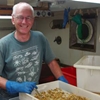General Description
Carapace middorsal ridge with 3 similar and evenly spaced teeth. Submedian spine absent. Dorsolateral ridge with 4-5 spines. Hepatic spine present. Lateral ridge with 1-4 spines. First leg subchelate (flat short claws ending in a finger fitting across an oblique palm); second legs much shorter than other legs. Third and fourth abdominal segments with middorsal crest. Up to 2.5 cm long.
Biology
Sand shrimps differ from all other caridean shrimps in having flat short chelipeds ending in a finger fitting across an oblique palm (rather than having two extended opposing fingers). All sand shrimps live on sandy sediments offshore but are so well disguised that they are rarely seen. This is the most common sand shrimp species encountered in sheltered environments such as Port Phillip Bay and Western Port.
Habitat
Subtidal and bay sediments, to 42 m depth.
Soft substrates
Coastal shores
Distribution guide
Southern temperate oceans, including southern Australia.
Species Group
Prawns, shrimps, lobsters › Shrimps
Depth
Shore (0-1 m)
Shallow (1-30 m)
Deep ( > 30 m)
Water Column
Max Size
25 mm
Diet
Organic matter
Commercial Species
No
Global Dispersal
Native to Australia
Species Code
MoV 1000
Conservation Status
- DSE Advisory List : Not listed
- EPBC Act 1999 : Not listed
- IUCN Red List : Not listed






